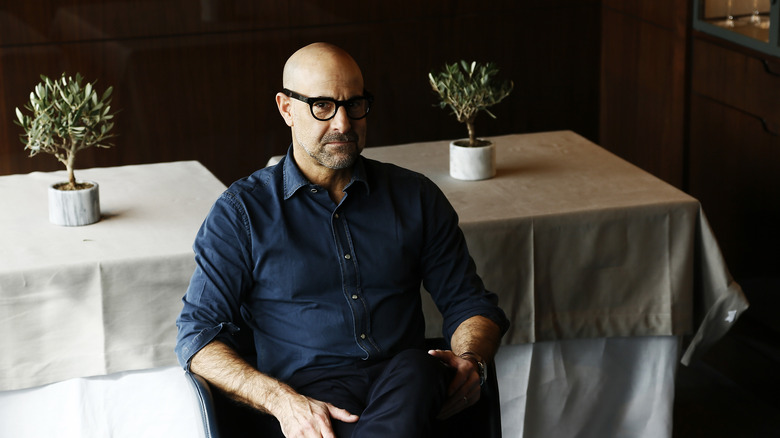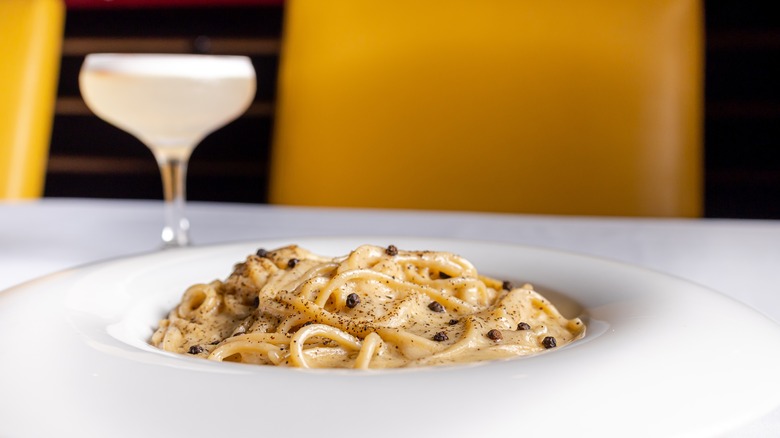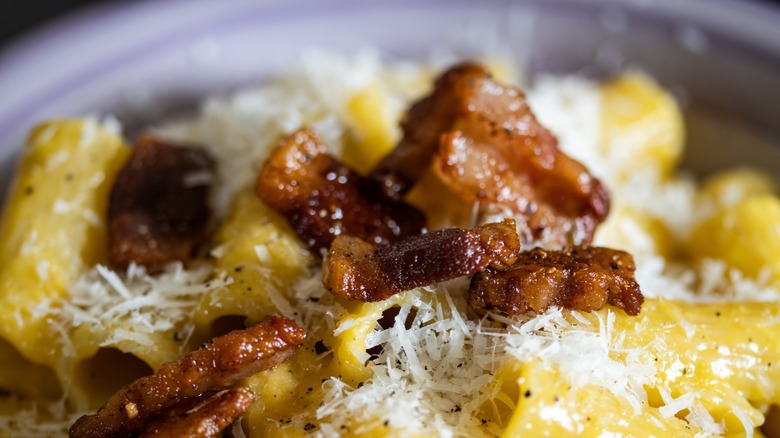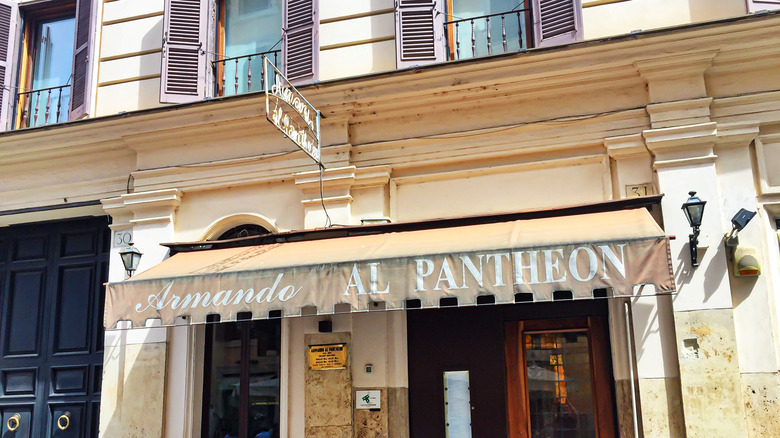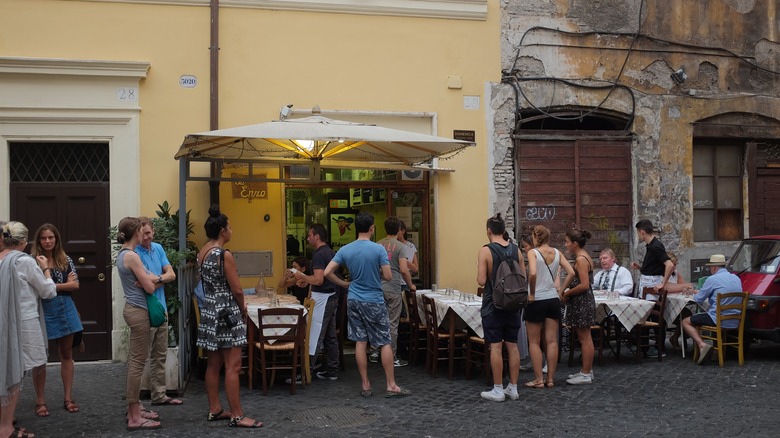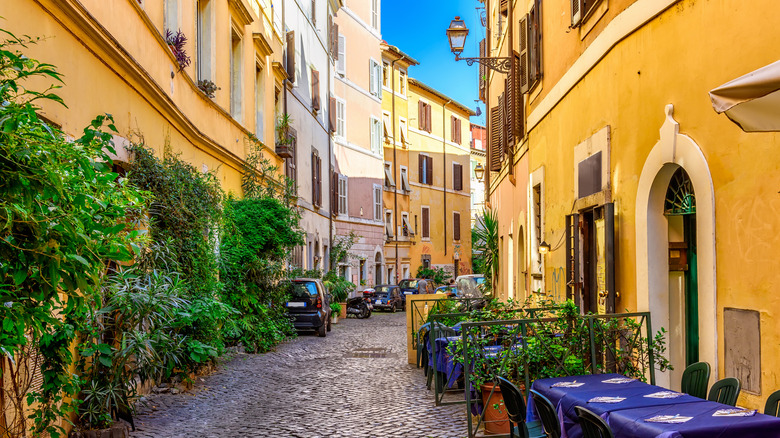These Restaurants Have The Best Pasta In Rome, According To Stanley Tucci
As travelers to Rome begin to etch their itineraries in stone, one question never fails to leave them disoriented after a long day of sightseeing: Where to find the best pasta in Rome? Fortunately, Stanley Tucci, actor, culinary traveler, and Italian-American, has already done the research while exploring the Italian peninsula on his latest hit show, "Searching for Italy." With Tucci's recommendations, you can glorify your Roman pilgrimage and savor the victory of experiencing authentic cuisine at its best restaurants.
However, before travelers grab a menu and place their order, they need to learn about Rome and its history of pasta. This history can be traced back as far as the fourth century after a discovery in the Etruscan tomb known as the Grotta Bella in Cerveteri, located about 25 miles northwest of the heart of Rome. Remarkably so, they found depictions of pasta tools that are still used today, like the pastry board, rolling pin, and cutting wheel.
Famous ancient Roman figures like Cicero and Horace also enthusiastically mention pasta (known as laganae at the time), highlighting it as a nutritional daily meal in most households. It was not until the 14th century that pasta became a staple of Italian cuisine as it is today. Out of the thousand types of pasta in Italy, Rome has four that have defined its cuisine for millennia: cacio e pepe, carbonara, amatriciana, and gricia. Now, let's dig into Stanley Tucci's favorite restaurants that serve them in the Eternal City.
Cacio e pepe: Bistrot64
When in Rome, you eat cacio e pepe. Indeed, a visit to the Eternal City is incomplete without indulging in this quintessential dish. Cacio e pepe is made of three ingredients — the name already gives away two of them — cacio (sheep's milk cheese) and black pepper. They unite with pasta and starchy pasta water to form one of the most creamy, rich, and inevitably addictive dishes. Easy to love, but difficult to make, cacio e pepe has humble roots in the kitchens of low-income families working in mines and factories in the Lazio region around the 1800s. The three ingredients were cheap, filling, and had a long shelf life. Today, the recipe fluctuates, with some restaurants garnishing it with black truffle and others adding Parmesan.
In "Searching for Italy," Stanley Tucci visits Bistrot64, a Michelin-recommended neo-bistro in Rome's Flaminio district. An unusual contender, Bistrot64 is a Japanese-Italian fusion restaurant that prides itself on seasonal dishes served in an intimate, warm, modern setting (that also converts to a cocktail bar after 11 p.m.). Chef Kotaro Noda, born and raised in Japan, has mastered the recipe of cacio e pepe, getting the balance of the three ingredients — cheese, pasta, and pepper — down to perfection. By combining the meticulousness and complexity of Japanese cooking techniques with the tradition and respect of the Italian kitchen, Bistrot64 is able to bring something new to the table with a dish as old and humble as cacio e pepe.
Carbonara: Pommidoro dal 1890 Ristorante
Pasta Carbonara, one of the most famous Italian pasta dishes, is shrouded in myth and speculation despite being a relatively new invention. Carbonara is a pasta made with a precise concoction of beaten eggs, browned pig jowl, and pecorino cheese. Although famously associated with Rome, some say it evolved from "pasta cacio e uova" (cheese, raw eggs, and melted lard), a dish first presented in 1839 by Ippolito Cavalcanti in his Neapolitan cookbook. Others claim it was a dish made by working outdoorsmen due to its simplicity and heartiness. Hence, the name derives from "carbonaro," or charcoal burner (the abundance of black pepper helps with aiding the resemblance). Or maybe it was hungry American soldiers with their "bacon and egg" spaghetti in the 1940s and 1950s. Nobody really knows for sure.
One thing is certain, according to Stanley Tucci: Pommidoro dal 1890 is the best restaurant to enjoy it. Founded in 1890, Pommidoro was once a wine shop that turned into a restaurant in 1926 and has now become one of Rome's oldest family-run restaurants. Located conveniently just 1 mile from Rome's Termini Station, it's hard to believe that this place remains a hidden gem. Most may know of it as the last place Pier Paolo Pasolini, a revolutionary poet, writer, filmmaker, and political figure, dined before his assassination. Pommidoro continues to serve many traditional dishes from the region of Lazio, all made with love by the locals working there.
Amatriciana: Armando al Pantheon
Amatriciana is an iconic pasta dish from Amatrice, a small town in the Lazio region, where Rome is the capital. Locals are particularly defensive about this dish and declare that the only ingredients permitted in the sauce are guanciale, pecorino cheese, white wine, tomatoes, olive oil, salt, pepper, and chili pepper. Any violation of this list is an offense to the dish and, by proxy, the inhabitants of Amatrice, who invented it around 500 years ago. Spaghetti is traditionally used, and guanciale (fatty pig jowl meat) is favored for its aroma and rich flavor versus any other cut.
To enjoy this unique dish, Stanley Tucci recommends heading to Armando al Pantheon. This iconic establishment has been around since 1961 and is very strategically located near the Pantheon (so you can explore it on a full stomach or reward yourself with a hearty bowl of pasta after sightseeing). Locals and visitors flock here for its homey, welcoming trattoria vibe and kind service — plus, it's a family-run establishment.
But we're here for the food, and this place delivers. Traditional Roman fare based on timeless recipes of classic dishes and an extensive wine list with nearly 400 labels is sure to guarantee a phenomenal meal. It specializes in pasta classics, and although it isn't located in Amatrice, Armando al Pantheon will delight you with its amatriciana — Tucci-approved. Scoring a table here could take a while, so be prepared to wait, but we assure you it'll be worth it.
Gricia: Da Enzo al 29 & Roscioli
The final Roman pasta of the quad is the gricia, which happens to be the ancestor of the amatriciana. Pasta gricia was created in either Amatrice or Grisciano (the debate continues) by Lazio shepherds with the few ingredients they had on hand. Gricia involves many amatriciana ingredients but is specifically made with pasta, guanciale, pecorino cheese, salt, and pepper. That's it. As you can see, one VIP ingredient is missing: "il pomodoro."
With all the love for tomatoes, you might be surprised to learn that the mighty red fruit didn't come to Italy until the 15th or 16th century. It was brought over by explorers who went to the New World and then quickly became a hallmark of the Roman kitchen. To put two and two together, if amatriciana came after the tomato influx, cacio e pepe dates to the 1800s, and carbonara was only invented around the 1940s or 1950s, this makes gricia the OG Roman pasta.
Although Stanley Tucci doesn't sample this particular dish on the show, he does recommend two other restaurants as a must-visit for their pasta. Da Enzo al 29, a hidden family-owned trattoria in Trastevere, serves Roman classics with local ingredients. Authentic Italian flavors in a rustic ambiance: What more can one ask for? Finally, Roscioli, a Campo de' Fiori restaurant that foodies may refer to as an "institution." This circa-1824 joint is also family-run (notice a recurring trend here?) and has an extensive menu that includes homemade pasta.
Choosing the right place for the right dish
Not all restaurants serving pasta in Rome are made the same, and not every restaurant can prepare every pasta dish the way it's actually supposed to be. As the most travel-trodden city in Italy with over 25 million foreign visitors, Rome's great gastronomic and pasta legacy can sometimes be tampered with by trattorias disguised as tourist traps. In his show, Stanley Tucci explains that Rome's great food can only be found if you know where to look. His recommendations are tried and true, but if you want to venture off or just walk into an eatery that fits better on your itinerary, check out our guide on how to avoid tourist-trap restaurants.
Some of Italy's more famous foodie regions, like Tuscany, Sicily, or Emilia-Romagna — responsible for foods like lasagna, Florentine steak, and cannoli — overshadow Rome's more humble culinary heritage. However, Rome is the ancient grandparent, or "nonni," of many of our modern obsessions, and like all nonni, it has perfected its pasta and continues to share it with the world. Whether you decide to try cacio e pepe, carbonara, amatriciana, gricia, or all of them, the taste of Rome is ever-present. Stanley Tucci understands this phenomenon because pasta is not just food here; it is a cultural icon that represents tradition, history, and the joy of food. From ancient laganae to modern-day classics, the Eternal City will continue to serve great pasta — you just need to know where to find the best.
